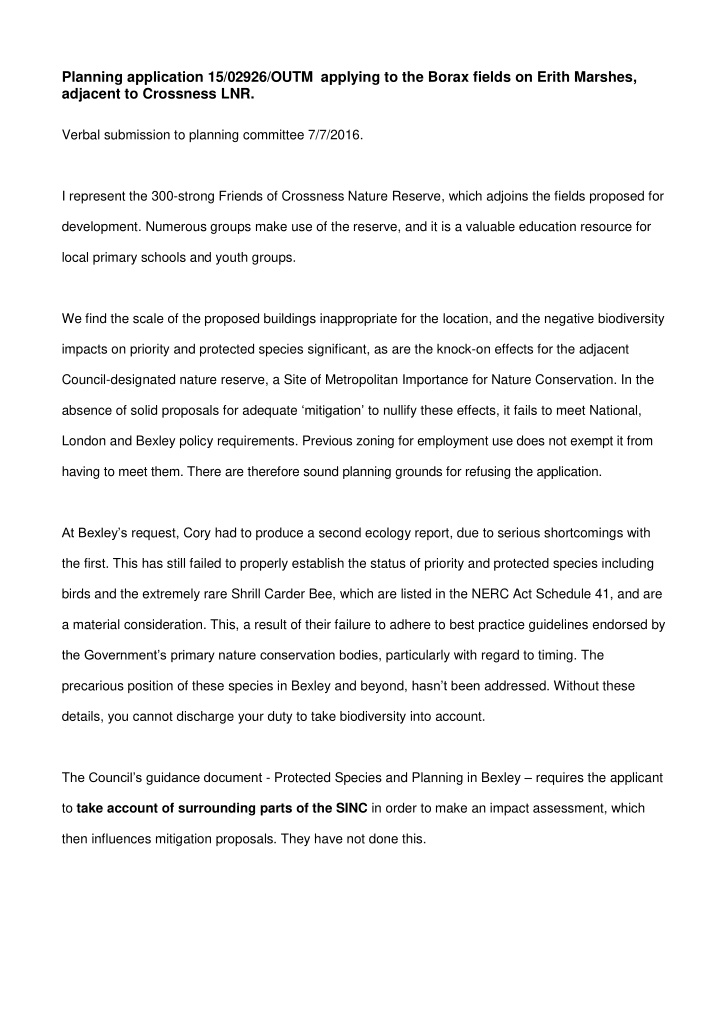



Planning application 15/02926/OUTM applying to the Borax fields on Erith Marshes, adjacent to Crossness LNR. Verbal submission to planning committee 7/7/2016. I represent the 300-strong Friends of Crossness Nature Reserve, which adjoins the fields proposed for development. Numerous groups make use of the reserve, and it is a valuable education resource for local primary schools and youth groups. We find the scale of the proposed buildings inappropriate for the location, and the negative biodiversity impacts on priority and protected species significant, as are the knock-on effects for the adjacent Council-designated nature reserve, a Site of Metropolitan Importance for Nature Conservation. In the absence of solid proposals for adequate ‘mitigation’ to nullify these effects, it fails to meet National, London and Bexley policy requirements. Previous zoning for employment use does not exempt it from having to meet them. There are therefore sound planning grounds for refusing the application. At Bexley’s request, Cory had to produce a second ecology report, due to serious shortcomings with the first. This has still failed to properly establish the status of priority and protected species including birds and the extremely rare Shrill Carder Bee, which are listed in the NERC Act Schedule 41, and are a material consideration. This, a result of their failure to adhere to best practice guidelines endorsed by the Government’s primary nature conservation bodies , particularly with regard to timing. The precarious position of these species in Bexley and beyond, hasn’t been addressed. Without these details, you cannot discharge your duty to take biodiversity into account. T he Council’s guidance document - Protected Species and Planning in Bexley – requires the applicant to take account of surrounding parts of the SINC in order to make an impact assessment, which then influences mitigation proposals. They have not done this.
Planning, as required by the National Planning Policy Framework, should seek to provide ‘net gains in biodiversity’ , ‘halt its overall decline ,’ and seek the ‘protection a nd recovery of priority species populations. ’ This application fails this test. If approved, two internationally declining, red-listed bird species – Skylark, a 50% UK decline, and Ringed Plover – will be lost as breeding species from Erith Marshes. Ringed Plover, along with the protected Little Ringed Plover, will be totally lost from Bexley. GONE. The applicant has admitted a total loss of the flower-rich open mosaic habitat - a national Biodiversity Action Plan habitat. There are only 7 UK populations of Shrill Carder Bee, which has been found both north and south of the fields – most recently last week. It is well documented that such open mosaic habitat is of major importance for this species. It should not built upon. Cory have stated ‘ the Proposed Development will not have a significant impact on the population or conservation status of protected or priority species because the fields support only a small population of breeding birds of a limited range of species ’ . UNTRUE! Borough-wide species extinction is a VERY significant impact and clearly contrary to Bexley’s own Core Strategy policy of protecting and enhancing biodiversity WITHIN THIS BOROUGH. Moreover, s ince Shrill Carder bees probably use the fields, Cory’s claim that they are merely of ‘ local interest for invertebrates ’ is flawed. Does Bexley want to be the Council that permitted extinction of the UK’s rarest bumblebee, the loss of breeding Skylark and 2 Plover species, for such a modest number of jobs? If Bexley does not defer or reject this application outright, it must insist on suitable mitigation. The London Plan 7.19 Biodiversity and Access to Nature requires: When considering proposals that would affect directly, indirectly or cumulatively, a site of recognised nature conservation interest, the following will apply: 1 avoid adverse impact to the biodiversity interest. Given the inadequacy of the ecology reports in respect of ‘material considerations’, an d lack of adequate mitigation or compensation - reject or defer the application.
2 minimize impact and seek mitigation. If minded to approve, then adequate mitigation must be a direct condition, not merely ‘explored’ . Large scale green and brown roofing might conceivably enable the Skylark and Plovers to continue breeding, possibly providing replacement forage for Shrill Carder bee. The applicant must prove this in advance and show that the height would not compromise such an outcome, but Bexley should condition this, or the NPPF test will be failed. Bexley must reject this application. Because: There WILL be significant impacts on priority and protected species, on the application area and adjacent nature reserve, as species commute across boundaries; there has been NO adequate on-site mitigation offered for the specified impacts; NO credible enhancements to offset them; and NO proposal for off-site compensation of any kind. These species are habitat specialists: t hey cannot just ‘go somewhere else’. Under the terms of the NPPF, planning permission should be refused. Zoning for employment does not mean exemption of these tests. People are strongly opposed to this application. 230 written objections and petition letters submitted, and over 1,000 people signing an online petition against it. Bexley must reject this application
Recommend
More recommend